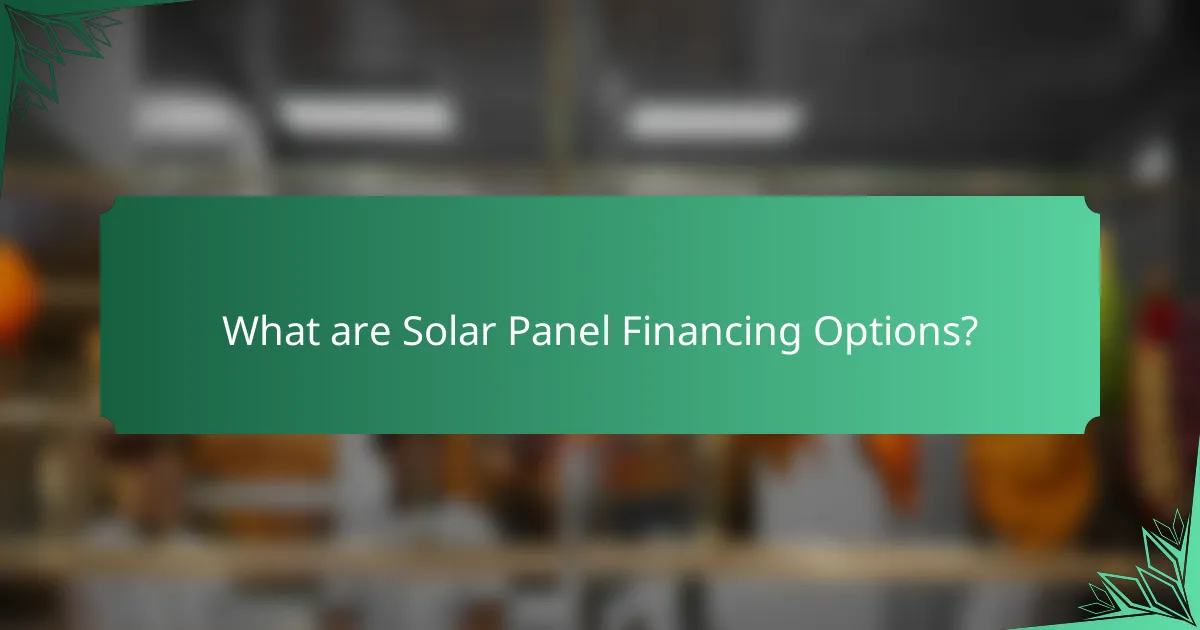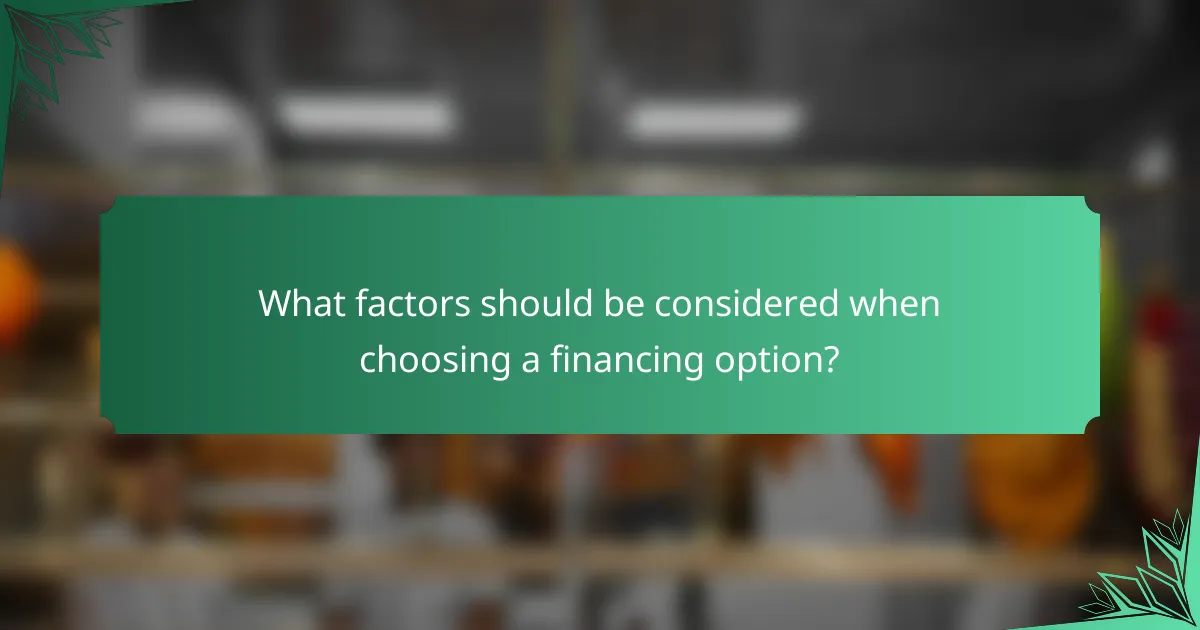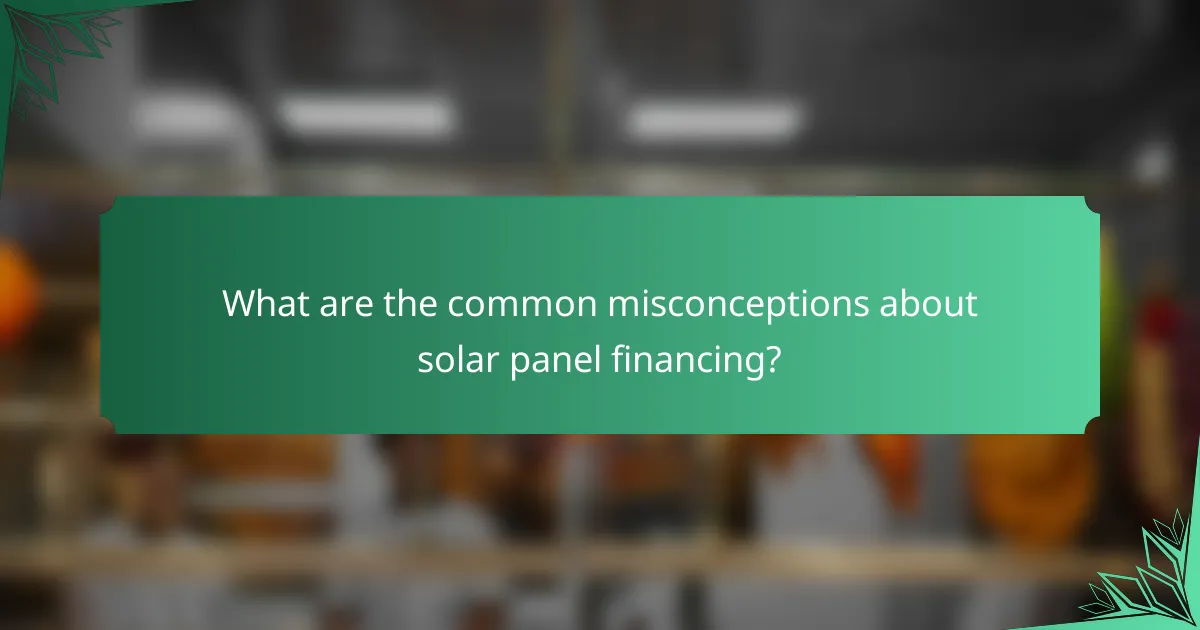
What are Solar Panel Financing Options?
Solar panel financing options include loans, leases, and power purchase agreements (PPAs). Loans allow homeowners to borrow money to purchase solar panels outright. This option provides ownership and potential tax benefits. Leases let homeowners use solar panels without upfront costs. Monthly payments are made for the lease term, and the leasing company retains ownership. PPAs involve paying for the energy produced by the solar panels instead of the panels themselves. This option often includes little to no upfront cost. Each financing option has different implications for ownership, savings, and tax incentives.
How do Loans for Solar Panels work?
Loans for solar panels provide financing to purchase solar energy systems. Borrowers apply for a loan from banks or credit unions. The loan amount typically covers the cost of equipment and installation. Borrowers repay the loan in monthly installments over a set term. Interest rates vary based on creditworthiness and market conditions. Federal and state incentives may reduce overall costs. Many loans are secured by the solar system itself. This means the lender can reclaim the system if payments are not made.
What types of loans are available for solar panel financing?
There are several types of loans available for solar panel financing. The most common options include secured loans, unsecured loans, and home equity loans. Secured loans require collateral, often the solar system itself, which can lead to lower interest rates. Unsecured loans do not require collateral but may have higher interest rates due to increased risk for lenders. Home equity loans allow homeowners to borrow against the equity in their home, often providing favorable terms. Additionally, some lenders offer specialized solar loans designed specifically for financing solar energy systems. These loans can provide tailored repayment options and competitive interest rates.
What are the eligibility requirements for solar panel loans?
Eligibility requirements for solar panel loans typically include a good credit score, stable income, and home equity. Lenders often require a credit score of at least 600 to 700. Proof of income, such as pay stubs or tax returns, is usually necessary. Homeownership is often a requirement, as lenders may want collateral. Some lenders also consider debt-to-income ratios. Additionally, specific programs may have unique requirements. Research indicates that these criteria help assess the borrower’s ability to repay the loan.
What is a Solar Lease?
A solar lease is a financing arrangement where a customer pays a fixed monthly fee to use a solar energy system. The solar provider owns and maintains the system. This allows customers to access solar energy without the upfront costs of purchasing the system. Typically, the lease term lasts between 15 to 25 years. During this period, the customer benefits from reduced electricity bills. The provider handles installation, maintenance, and repairs. This makes solar leasing an attractive option for those who want solar energy without the responsibilities of ownership.
How does a solar lease differ from purchasing solar panels outright?
A solar lease allows a homeowner to use solar panels without owning them. The homeowner pays a monthly fee to a solar company for the use of the panels. In contrast, purchasing solar panels outright means the homeowner buys the panels and owns them. This ownership allows the homeowner to benefit from tax credits and incentives.
With a solar lease, maintenance and repairs are typically the responsibility of the solar company. When purchasing, the homeowner assumes responsibility for maintenance. The upfront cost for purchasing is usually higher compared to the lower initial costs associated with a lease.
In summary, a solar lease involves payments for usage without ownership, while purchasing means full ownership and associated benefits.
What are the advantages and disadvantages of solar leasing?
The advantages of solar leasing include lower upfront costs and no maintenance responsibilities. Homeowners can install solar panels without significant financial investment. Leasing also allows for predictable monthly payments. Additionally, many leasing companies offer performance guarantees.
The disadvantages of solar leasing include a lack of ownership and potential long-term costs. Homeowners do not build equity in the system. Lease agreements may last 20 years or more, potentially leading to higher overall expenses. Moreover, solar leasing can complicate property sales. Buyers may be deterred by existing lease agreements.
What is a Power Purchase Agreement (PPA)?
A Power Purchase Agreement (PPA) is a contract between a power producer and a buyer. The buyer agrees to purchase electricity generated by the producer at a predetermined price. PPAs are commonly used in renewable energy projects, especially solar. They help facilitate financing for solar installations by providing revenue certainty. According to the Solar Energy Industries Association, PPAs have become a popular financing option in the solar market. This model allows companies to procure solar energy without upfront capital costs. The agreement typically spans 15 to 25 years, ensuring long-term energy supply.
How does a PPA function in solar panel financing?
A Power Purchase Agreement (PPA) is a financial arrangement for solar panel financing. In a PPA, a third-party developer installs and maintains solar panels on a property. The property owner agrees to purchase the electricity generated at a predetermined rate. This rate is typically lower than the local utility’s rate. The contract usually spans 15 to 25 years. During this period, the property owner benefits from reduced energy costs. The developer recoups the installation costs through the electricity sales. Studies show that PPAs can lead to significant savings for businesses and homeowners.
What are the long-term implications of entering a PPA?
Entering a Power Purchase Agreement (PPA) can have several long-term implications. First, a PPA typically locks in energy prices for a specified duration, often 10 to 25 years. This can provide financial predictability and protect against rising electricity costs. Second, the responsibility for maintenance and operation of the solar system usually falls on the provider, reducing the burden on the consumer. Third, PPAs may affect property value; properties with solar installations can be more attractive to buyers. Fourth, entering a PPA may limit options for system upgrades or changes during the contract term. Additionally, long-term agreements can tie consumers to a specific provider, which may impact future energy choices. Finally, regulatory changes could affect the terms and benefits of the PPA over time, making it essential for consumers to understand these potential shifts.
How do these financing options compare?
Loans typically require upfront payments and monthly installments. They allow ownership of the solar system, leading to potential tax benefits. Leases often involve lower initial costs with fixed monthly payments. However, the leasing company retains ownership, limiting tax incentives for the homeowner. Power Purchase Agreements (PPAs) offer energy at a set rate, usually lower than utility prices. Homeowners pay for the energy produced rather than the system itself. Overall, loans provide ownership benefits, while leases and PPAs offer lower upfront costs with trade-offs in ownership and incentives.
What are the key differences between loans, leases, and PPAs?
Loans involve borrowing money to purchase solar panels, with repayment over time. The borrower owns the system and benefits from tax credits and incentives. Leases allow users to pay a fixed monthly fee to use solar panels without ownership. The leasing company retains tax benefits and maintenance responsibilities. Power Purchase Agreements (PPAs) are contracts to buy electricity generated by solar panels at a set rate. Customers do not own the system and typically have lower upfront costs. In summary, loans provide ownership, leases offer usage without ownership, and PPAs focus on purchasing energy rather than the system itself.
Which financing option is best for different types of consumers?
Homeowners seeking ownership should consider solar loans. Loans allow for full ownership and potential tax credits. Consumers wanting low upfront costs might prefer leases. Leases provide fixed monthly payments without maintenance worries. Power Purchase Agreements (PPAs) suit those wanting minimal responsibility. PPAs charge for energy produced, offering flexibility. Each option aligns with different financial goals and risk tolerances. Understanding these distinctions helps consumers make informed decisions.

What factors should be considered when choosing a financing option?
When choosing a financing option for solar panels, consider the total cost of ownership. This includes upfront costs, interest rates, and any fees associated with the financing. Evaluate the loan term or lease duration, as it affects monthly payments and overall financial commitment. Analyze the potential energy savings and incentives available, such as tax credits or rebates, which can impact the overall value. Assess your credit score, as it influences loan approval and interest rates. Consider your long-term plans for the property, as this affects the suitability of loans versus leases or power purchase agreements (PPAs). Review the flexibility of the financing option, including terms for early payoff or transferring agreements. Lastly, research the reputation of the financing provider to ensure reliability and support throughout the financing period.
How do interest rates affect solar panel financing choices?
Interest rates significantly impact solar panel financing choices. Lower interest rates make loans more affordable, encouraging more homeowners to finance solar installations. Conversely, higher interest rates increase the cost of borrowing, which can deter potential buyers. For instance, a 1% increase in interest rates can raise monthly payments on a solar loan by approximately 10%. This financial burden may lead some consumers to consider leasing options or power purchase agreements (PPAs) instead. In these alternatives, the upfront costs are lower, but overall savings may be reduced compared to ownership. Therefore, the prevailing interest rate environment plays a crucial role in determining which financing option is most appealing to consumers.
What are the current trends in solar financing interest rates?
Current trends in solar financing interest rates show a gradual decline. As of late 2023, average interest rates for solar loans are approximately 4% to 6%. This decrease is attributed to increased competition among lenders. Additionally, government incentives and subsidies are influencing lower rates. Many financial institutions are offering tailored solar financing products. These products often come with flexible terms and conditions. The overall trend reflects a growing acceptance of solar energy solutions. This acceptance is further supported by rising energy costs and environmental awareness.
What impact do tax incentives have on financing decisions?
Tax incentives significantly influence financing decisions in solar panel investments. They reduce the overall cost of installation. This makes solar projects more financially attractive. For instance, the federal Investment Tax Credit (ITC) allows a 26% deduction on installation costs. Such incentives encourage both loans and leases for financing. They improve cash flow and return on investment. As a result, more homeowners and businesses opt for solar financing options. According to the Solar Energy Industries Association, tax incentives have driven solar installations to record levels.
How can federal and state incentives affect the overall cost?
Federal and state incentives can significantly reduce the overall cost of solar panel installations. These incentives often include tax credits, rebates, and grants. For instance, the federal solar tax credit allows homeowners to deduct 26% of the installation cost from their federal taxes. This can result in substantial savings, making solar energy more affordable. Additionally, many states offer their own incentives, which can further decrease upfront expenses. According to the Solar Energy Industries Association, these combined incentives can lower the cost of solar systems by thousands of dollars. Therefore, utilizing federal and state incentives is crucial for maximizing savings on solar energy investments.

What are the common misconceptions about solar panel financing?
Common misconceptions about solar panel financing include the belief that solar panels are always too expensive. Many financing options, such as loans and leases, can make solar energy accessible. Another misconception is that solar financing requires a high credit score. Some programs cater to individuals with lower credit ratings. People often think that financing means long-term commitments. However, options like power purchase agreements (PPAs) can offer flexibility. Additionally, some believe that financing solar panels leads to increased property taxes. In many regions, solar installations can qualify for tax exemptions. Lastly, there is a notion that solar financing is only for homeowners. Businesses and renters can also access various financing solutions.
Why do some people believe solar financing is too complicated?
Some people believe solar financing is too complicated due to the variety of options available. Solar financing includes loans, leases, and power purchase agreements (PPAs). Each option has different terms, conditions, and implications. The complexity increases with varying interest rates and payment structures. Many individuals find it difficult to compare these financing methods. Additionally, there may be a lack of clear information about incentives and rebates. Misunderstandings about solar technology can also contribute to confusion. As a result, potential customers may feel overwhelmed by the choices and details involved.
What resources are available to simplify the financing process?
Resources available to simplify the financing process include online calculators, financial institutions, and government programs. Online calculators help estimate costs and savings associated with solar panel installations. Financial institutions offer specialized loans and financing options tailored for solar projects. Government programs provide incentives and rebates, reducing overall financing needs. Additionally, solar companies often assist with financing options, streamlining the application process. These resources collectively make it easier for consumers to navigate financing for solar energy solutions.
What are the most common myths about solar leases and PPAs?
Common myths about solar leases and Power Purchase Agreements (PPAs) include the belief that they are the same as purchasing solar panels. In reality, solar leases and PPAs allow users to access solar energy without upfront costs. Another myth is that homeowners lose tax benefits when opting for these financing methods. However, tax credits typically apply to the system owner, which is often the leasing company or PPA provider. Some believe that solar leases and PPAs lock them into long-term contracts without flexibility. Many agreements, in fact, offer options for early termination or buyout. There is also a misconception that these options are only available for residential properties. Commercial entities can also benefit from solar leases and PPAs. Lastly, some think that solar leases and PPAs do not lead to savings on energy bills. Numerous case studies show that users often experience reduced energy costs over time.
How can understanding these myths lead to better decision-making?
Understanding myths about solar panel financing options can lead to better decision-making by clarifying misconceptions. Misunderstandings can cause individuals to overlook viable financing methods like loans, leases, or power purchase agreements (PPAs). Accurate knowledge enables consumers to assess the true costs, benefits, and risks associated with each option. For example, believing that leasing is always cheaper can prevent individuals from considering long-term savings from ownership through loans. Additionally, understanding the terms and conditions of each financing method helps in making informed choices that align with financial goals. Research from the National Renewable Energy Laboratory indicates that informed consumers are more likely to invest in solar solutions that maximize their savings and energy efficiency.
What are the best practices for selecting a solar financing option?
Evaluate your budget and financial goals before selecting a solar financing option. Understand the total cost of installation and available incentives. Research different financing methods such as loans, leases, and power purchase agreements (PPAs). Compare interest rates and terms from multiple lenders. Assess the impact of each option on your monthly cash flow. Consider the long-term savings associated with ownership versus leasing. Review the reputation and customer service of the financing provider. Analyze the flexibility of the financing terms, including prepayment options.
Solar panel financing options encompass various methods, including loans, leases, and power purchase agreements (PPAs), each with distinct implications for ownership, savings, and tax incentives. Loans allow homeowners to purchase solar panels outright, providing ownership and potential tax benefits, while leases enable users to access solar energy without upfront costs, with fixed monthly payments. PPAs involve paying for the energy produced by solar panels at a predetermined rate, often with little to no initial investment. The article explores the mechanics, eligibility requirements, advantages, and disadvantages of each financing option, along with current trends, tax incentives, and common misconceptions, aiding consumers in making informed decisions about solar energy investments.